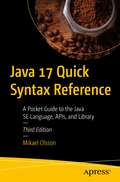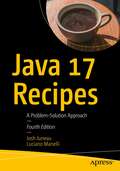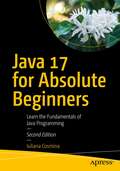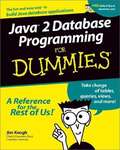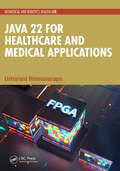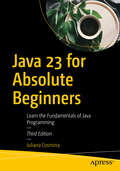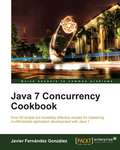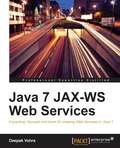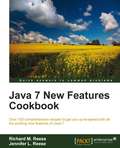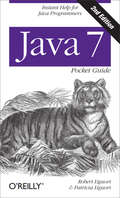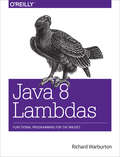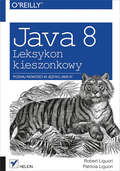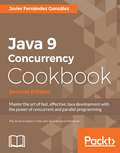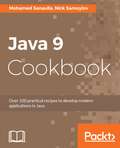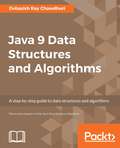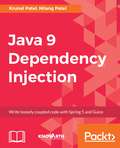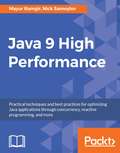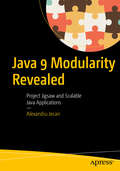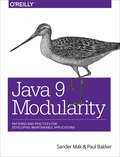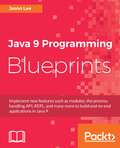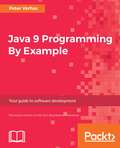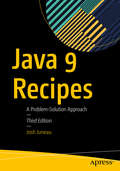- Table View
- List View
Java 17 Quick Syntax Reference: A Pocket Guide to the Java SE Language, APIs, and Library
by Mikael OlssonQuickly gain the insight necessary to address a multitude of Java coding challenges using this succinct reference guide, Java 17 Quick Syntax Reference, Third Edition. Short, focused code examples will help you learn and master various existing and new Java source code elements. This edition includes the following additions to Java SE and OpenJDK, through Java 17: Pattern matching for switch and instanceof, Sealed classes and interfaces, Switch expressions, Text block multiline strings, Java module system, Private methods in interfaces, and Type inference for local variables. You won’t find any technical jargon, bloated samples, drawn out history lessons or witty stories in this book. What you will find is a language reference that is concise, to the point and highly accessible. The book is packed with useful information and is a must-have for any Java programmer.What You Will LearnRun a Java file with a single commandLearn what a switch expression is and how to use itUse pattern matchingCode with Java modulesCreate text blocks to handle multiline stringsLearn what sealed classes are and how to use these and moreWho This Book Is ForThose with prior experience with Java who want a quick and handy reference.
Java 17 Recipes: A Problem-Solution Approach
by Josh Juneau Luciano ManelliQuickly find solutions to dozens of common programming problems encountered while building Java applications, with recipes presented in the popular problem-solution format. Look up the programming problem that you want to resolve. Read the solution. Apply the solution directly in your own code. Problem solved!Java 17 Recipes is updated to reflect changes in specification and implementation since the Java 9 edition of this book. Java 17 is the next long-term support release (LTS) of the core Java Standard Edition (SE) version 17 which also includes some of the features from previous short term support (STS) releases of Java 16 and previous versions. This new edition covers of some of the newest features, APIs, and more such as pattern matching for switch, Restore Always-Strict-Floating-Point-Semantics, enhanced pseudo-random number generators, the vector API, sealed classes, and enhancements in the use of String. Source code for all recipes is available in a dedicated GitHub repository. This must-have reference belongs in your library.What You Will Learn Look up solutions to everyday problems involving Java SE 17 LTS and other recent releasesDevelop Java SE applications using the latest in Java SE technologyIncorporate Java major features introduced in versions 17, 16, and 15 into your code Who This Book Is For Programmers and developers with some prior Java experience.
Java 17 for Absolute Beginners: Learn the Fundamentals of Java Programming
by Iuliana CosminaWrite your first code in Java 17 using simple, step-by-step examples that model real-word objects and events, making learning easy. With Java 17 for Absolute Beginners you’ll be able to pick up the concepts without fuss. It teaches Java development in language anyone can understand, giving you the best possible start. You’ll see clear code descriptions and layout so that you can get your code running as soon as possible. Author Iuliana Cosmina focuses on practical knowledge and getting you up to speed quickly—all the bits and pieces a novice needs to get started programming in Java. First, you’ll discover what type of language Java is, what it is good for, and how it is executed. With the theory out of the way, you’ll install Java, choose an editor such as IntelliJ IDEA, and write your first simple Java program. Along the way you’ll compile and execute this program so it can run on any platform that supports Java. As part of this tutorial you’ll see how to write high-quality code by following conventions and respecting well-known programming principles, making your projects more professional and efficient. Java 17 for Absolute Beginners gives you all you need to start your Java programming journey. No experience necessary. After reading this book, you'll come away with the basics to get started writing programs in Java. What You Will Learn Get started with Java 17 from scratch Use data types, operators, and the stream API Install and use the IntelliJ IDEA and the Gradle build tool Exchange data using the new JSON APIs Play with images using multi-resolution APIs Implement the publish-subscribe architecture Who This Book Is For Those who are new to programming and who want to start with Java.
Java 2 Database Programming for Dummies
by Jim KeoghJava 2 Database Programming For Dummies shows you how to design, develop, and interact with a database using the Java programming language. This is the perfect book for those who know the basics of Java programming but have little or no experience creating and accessing a database in Java. The companion CD contains the source code for all the code fragments and examples in the book plus powerful tools, applets, drivers, and utilities.
Java 22 for Healthcare and Medical Applications (Biomedical and Robotics Healthcare)
by Usharani BhimavarapuThis comprehensive book delves into the key features introduced in Java 22, providing insights and practical examples to help readers understand and implement these enhancements within the context of medical applications with the goal of enhancing medical practices, streamlining processes, and improving patient care.Java 22 for Healthcare and Medical Applications explores the latest Java 22 and features the newest advancements in Java programming, including unnamed variables, launch multi-file source-code programs, and foreign function and memory APIs. From implementing advanced algorithms for medical image analysis to developing efficient healthcare management systems, this book shows how this tool can revolutionize the medical field. With its focus on accessibility, interoperability, and data security, this book empowers healthcare professionals to leverage technology in innovative ways, ultimately leading to better patient outcomes and improved healthcare delivery. Whether it's optimizing electronic health record systems, developing telemedicine platforms, or advancing medical research through data analysis, the author equips medical professionals with the knowledge and skills needed to harness the full potential of Java programming in the healthcare industry. With clear explanations and 300+ hands-on examples, readers will learn how to leverage Java 22's cutting-edge features to build powerful and efficient applications.The book caters to a diverse audience ranging from students to professionals and provides valuable insights into the latest advancements in Java programming and its applications within healthcare and medical technology.
Java 23 for Absolute Beginners: Learn the Fundamentals of Java Programming
by Iuliana CosminaWrite your first code in Java 23 using simple, step-by-step examples that model real-word objects and events, making learning easy. With this book you will be able to pick up core programming concepts without fuss and write efficient Java code in no time. Clear code descriptions and layout ensure you get your code running as soon as possible. Author Iuliana Cosmina focuses on practical knowledge and getting you up to speed quickly—all the bits and pieces a novice needs to get started programming in Java. In this edition, you will discover how Java has changed since version 17, and how to design and write code using the most recently introduced Java features such as new collection methods, virtual threads, pattern and record matching in switch expressions, structured concurrency tasks, unnamed classes and instance methods, and many more. This book is a complete Java guide, covering the following topics: setting up a development environment, programming concepts and well-known programming principles, writing Java code following industry-specific design patterns and coding conventions, executing it, debugging, testing, documenting it and even using specialized tools such as IntelliJ IDEA for writing Java code, Maven for building, JUnit Jupiter for testing, and in-memory and Docker-hosted databases or data storage. After reading this book, you’ll have all the necessary skills and knowledge to pass an interview for a starting Java development position. What You Will Learn Set up a Java development environment Use the Java language to write high-quality code Understand fundamental programming concepts and algorithms Use virtual threads, records, and other Java renown features Debug, test, and document Java code Improve performance by customizing the Garbage Collector Who This Book Is For Those who are new to programming and want to learn Java and use it to build efficient solutions
Java 2D Graphics
by Jonathan KnudsenJava 2D Graphics describes the 2D API from top to bottom, demonstrating how to set line styles and pattern fills as well as more advanced techniques of image processing and font handling. You'll see how to create and manipulate the three types of graphics objects: shapes, text, and images. Other topics include image data storage, color management, font glyphs, and printing.
Java 7 Concurrency Cookbook
by Javier Fernandez"Java 7 Concurrency Cookbook" is a practical Cookbook packed with real-world solutions. Intermediate-advanced level Java developers will learn from task-based recipes to use Java's concurrent API to program thread safe solutions.If you are a Java developer who wants to take your knowledge of concurrent programming and multithreading further, as well as discover the new concurrency features of Java 7, then "Java 7 Concurrency Cookbook" is for you.
Java 7 JAX-WS Web Services
by Deepak VohraThis book takes a practical approach for building JAX WS web services with Java 7. Plenty of sample code and screenshots are used to help you apply these concepts in a real-world scenario. This book is targeted at developers who want to create web services with Java 7. If you use NetBeans-Glassfish for Java EE development you would be interested in how the new wsimport clientjar option may be leveraged to simplify web service development.
Java 7 New Features Cookbook
by Richard M. Reese Jennifer L. ReeseEach recipe comprises step-by-step instructions followed by an analysis of what was done in each task and other useful information. The book is designed so that you can read it chapter by chapter, or look at the list of recipes and refer to them in no particular order. Each example comes with its expected output to make your learning even easier. This book is designed to bring those who are familiar with Java up-to-speed on the new features found in Java 7.
Java 7 Pocket Guide: Instant Help for Java Programmers
by Patricia Liguori Robert LiguoriWhen you need quick answers for developing or debugging Java programs, this pocket guide provides a handy reference to the standard features of the Java programming language and its platform. You’ll find helpful programming examples, tables, figures, and lists, as well as supplemental information about topics including the Java Scripting API, third-party tools, and the basics of the Unified Modeling Language (UML).Updated for new features through Java SE 7, this little book is an ideal companion, whether you’re in the office, in the lab, or on the road.Quickly find Java language details, such as naming conventions, fundamental types, and object-oriented programming elementsGet details on the Java SE 7 platform, including development basics, memory management, concurrency, and genericsBrowse through basic information on NIO 2.0, the G1 Garbage Collector, and Project Coin (JSR-334) featuresGet supplemental references to development, CM, and test tools; libraries; IDEs; and Java-related scripting languagesFind information to help you prepare for the Oracle Certified Associate Java SE 7 Programmer I exam
Java 8 Lambdas: Pragmatic Functional Programming
by Richard WarburtonIf you’re a developer with core Java SE skills, this hands-on book takes you through the language changes in Java 8 triggered by the addition of lambda expressions. You’ll learn through code examples, exercises, and fluid explanations how these anonymous functions will help you write simple, clean, library-level code that solves business problems.Lambda expressions are a fairly simple change to Java, and the first part of the book shows you how to use them properly. Later chapters show you how lambda functions help you improve performance with parallelism, write simpler concurrent code, and model your domain more accurately, including building better DSLs.Use exercises in each chapter to help you master lambda expressions in Java 8 quicklyExplore streams, advanced collections, and other Java 8 library improvementsLeverage multicore CPUs and improve performance with data parallelismUse techniques to “lambdify” your existing codebase or library codeLearn practical solutions for lambda expression unit testing and debuggingImplement SOLID principles of object-oriented programming with lambdasWrite concurrent applications that efficiently perform message passing and non-blocking I/O
Java 8. Leksykon kieszonkowy
by Patricia Liguori Robert Liguori??Java jest dzi? j?zykiem, który programi?ci wybieraj? najcz??ciej, gdy maj? przed sob? skomplikowany projekt, wymagaj?cy najwy?szej wydajno?ci, jako?ci, bezpiecze?stwa oraz integracji z innymi systemami. Rozwijany od blisko dwudziestolecia, j?zyk ten doczeka? si? wersji oznaczonej numerem 8. Ta edycja zosta?a wzbogacona o wiele nowo?ci, m.in. o d?ugo oczekiwane wyra?enia lambda. Je?eli szukasz por?cznej ksi??ki, do której mo?esz si?gn?? w przypadku w?tpliwo?ci, to trafi?e? na doskona?? pozycj?!Ta publikacja nale?y do popularnej serii „Leksykon kieszonkowy” i mo?esz mie? j? zawsze przy sobie. W ?rodku znajdziesz konwencje nazw oraz podstawowe elementy j?zyka. W kolejnych rozdzia?ach zdob?dziesz wiedz? na temat typów prostych oraz programowania zorientowanego obiektowo. Ponadto zawarto tu przyst?pne omówienie wyra?e? lambda, wspó?bie?no?ci oraz zasad dost?pu do plików i sieci. Java posiada rozbudowany mechanizm obs?ugi sytuacji wyj?tkowych, który równie? zosta? omówiony w tym podr?czniku. Ksi??ka ta jest obowi?zkow? pozycj? na pó?ce ka?dego programisty j?zyka Javy — je?li chce on mie? zawsze pod r?k? wiarygodne ?ród?o informacji na temat tego j?zyka.Dzi?ki tej ksi??ce:- poznasz elementy i sk?adni? j?zyka Java- zrozumiesz zasad? dzia?ania wyra?e? lambda- wykorzystasz nowe metody dost?pu do plików- zaznajomisz si? z nowo?ciami w Javie 8- b?dziesz mie? zawsze pod r?k? solidne ?ród?o wiedzyTwój przewodnik po j?zyku Java!
Java 9 Concurrency Cookbook - Second Edition
by Javier Fernandez GonzalezMaster the art of fast, effective Java development with the power of concurrent and parallel programming About This Book • Get detailed coverage of important recipes on multi-threading and parallel programming • This book takes a close look at the Java 9 APIs and their impact on concurrency • See practical examples on thread safety, high-performance classes, safe sharing, and a whole lot more Who This Book Is For The book is for Java developers and programmers at an intermediate to advanced level. It will be especially useful for developers who want to take advantage of task-based recipes using Java 9's concurrent API to program thread-safe solutions. What You Will Learn • Find out to manage the basic components of the Java Concurrency API • Use synchronization mechanisms to avoid data race conditions and other problems of concurrent applications • Separate the thread management from the rest of the application with the Executor framework • Solve problems using a parallelized version of the divide and conquer paradigm with the Fork / Join framework • Process massive data sets in an optimized way using streams and reactive streams • See which data structures we can use in concurrent applications and how to use them • Practice efficient techniques to test concurrent applications • Get to know tips and tricks to design concurrent applications In Detail Writing concurrent and parallel programming applications is an integral skill for any Java programmer. Java 9 comes with a host of fantastic features, including significant performance improvements and new APIs. This book will take you through all the new APIs, showing you how to build parallel and multi-threaded applications. The book covers all the elements of the Java Concurrency API, with essential recipes that will help you take advantage of the exciting new capabilities. You will learn how to use parallel and reactive streams to process massive data sets. Next, you will move on to create streams and use all their intermediate and terminal operations to process big collections of data in a parallel and functional way. Further, you'll discover a whole range of recipes for almost everything, such as thread management, synchronization, executors, parallel and reactive streams, and many more. At the end of the book, you will learn how to obtain information about the status of some of the most useful components of the Java Concurrency API and how to test concurrent applications using different tools. Style and approach This recipe-based book will allow you to explore the exciting capabilities of concurrency in Java. After reading this book, you will be able to comfortably build parallel applications in Java 9.
Java 9 Cookbook
by Mohamed Sanaulla Nick SamoylovA definitive guide to learning the key concepts of modern application development in Java About This Book • Learn the latest features of Java 9 • Extend your Java knowledge and take your application to new levels by making it fast, secure, and scalable • Delve into the intricacies of Modular programming in Java 9 Who This Book Is For The book is for intermediate to advanced Java programmers who want to make their applications fast, secure, and scalable. What You Will Learn • Set up JDK and know the differences in the JDK 9 installation • Implement OO designs using classes and interfaces • Manage operating system processes • Understand the new modular JDK and modular programming • Create a modular application with clear dependencies • Build graphical user interfaces using JavaFX • Use the new HTTP Client API • Learn about the new diagnostic features in Java 9 • See how to use the new jShell REPL tool • Execute ES6-compliant JavaScript code from your Java applications In Detail Java is an object-oriented programming language. It is one of the most widely accepted languages because of its design and programming features, particularly in its promise that you can write a program once and run it anywhere. This cookbook offers a range of software development examples in simple and straightforward Java 9 code, providing step-by-step resources and time-saving methods to help you solve data problems efficiently. Starting with the installation of Java, each recipe addresses a specific problem, with a discussion that explains the solution and offers insight into how it works. We cover major concepts such as Project Jigsaw and various tools that will enable you to modularize your applications. You will learn new features in the form of recipes that will make your applications modular, secure, and fast. Style and approach Each recipe in this book contains a series of complete instructions to perform a core task, plus an explanation of the purpose behind it. Similar methods or further refinements are included with each recipe to provide comprehensive guidance.
Java 9 Data Structures and Algorithms
by Debasish Ray ChawdhuriGain a deep understanding of the complexity of data structures and algorithms and discover the right way to write more efficient code About This Book • This book provides complete coverage of reactive and functional data structures • Based on the latest version of Java 9, this book illustrates the impact of new features on data structures • Gain exposure to important concepts such as Big-O Notation and Dynamic Programming Who This Book Is For This book is for Java developers who want to learn about data structures and algorithms. Basic knowledge of Java is assumed. What You Will Learn • Understand the fundamentals of algorithms, data structures, and measurement of complexity • Find out what general purpose data structures are, including arrays, linked lists, double ended linked lists, and circular lists • Get a grasp on the basics of abstract data types—stack, queue, and double ended queue • See how to use recursive functions and immutability while understanding and in terms of recursion • Handle reactive programming and its related data structures • Use binary search, sorting, and efficient sorting—quicksort and merge sort • Work with the important concept of trees and list all nodes of the tree, traversal of tree, search trees, and balanced search trees • Apply advanced general purpose data structures, priority queue-based sorting, and random access immutable linked lists • Gain a better understanding of the concept of graphs, directed and undirected graphs, undirected trees, and much more In Detail Java 9 Data Structures and Algorithms covers classical, functional, and reactive data structures, giving you the ability to understand computational complexity, solve problems, and write efficient code. This book is based on the Zero Bug Bounce milestone of Java 9. We start off with the basics of algorithms and data structures, helping you understand the fundamentals and measure complexity. From here, we introduce you to concepts such as arrays, linked lists, as well as abstract data types such as stacks and queues. Next, we'll take you through the basics of functional programming while making sure you get used to thinking recursively. We provide plenty of examples along the way to help you understand each concept. You will get the also get a clear picture of reactive programming, binary searches, sorting, search trees, undirected graphs, and a whole lot more! Style and approach This book will teach you about all the major algorithms in a step-by-step manner. Special notes on the Big-O Notation and its impact on algorithms will give you fresh insights.
Java 9 Dependency Injection: Write loosely coupled code with Spring 5 and Guice
by Nilang Patel Krunal PatelCreate clean code with Dependency Injection principlesKey FeaturesUse DI to make your code loosely coupled to manage and test your applications easily on Spring 5 and Google GuiceLearn the best practices and methodologies to implement DIWrite more maintainable Java code by decoupling your objects from their implementationsBook DescriptionDependency Injection (DI) is a design pattern that allows us to remove the hard-coded dependencies and make our application loosely coupled, extendable, and maintainable. We can implement DI to move the dependency resolution from compile-time to runtime. This book will be your one stop guide to write loosely coupled code using the latest features of Java 9 with frameworks such as Spring 5 and Google Guice. We begin by explaining what DI is and teaching you about IoC containers. Then you’ll learn about object compositions and their role in DI. You’ll find out how to build a modular application and learn how to use DI to focus your efforts on the business logic unique to your application and let the framework handle the infrastructure work to put it all together. Moving on, you’ll gain knowledge of Java 9’s new features and modular framework and how DI works in Java 9. Next, we’ll explore Spring and Guice, the popular frameworks for DI. You’ll see how to define injection keys and configure them at the framework-specific level. After that, you’ll find out about the different types of scopes available in both popular frameworks. You’ll see how to manage dependency of cross-cutting concerns while writing applications through aspect-oriented programming.Towards the end, you’ll learn to integrate any third-party library in your DI-enabled application and explore common pitfalls and recommendations to build a solid application with the help of best practices, patterns, and anti-patterns in DI. What you will learnUnderstand the benefits of DI and fo from a tightly coupled design to a cleaner design organized around dependencies See Java 9’s new features and modular frameworkSet up Guice and Spring in an application so that it can be used for DIWrite integration tests for DI applicationsUse scopes to handle complex application scenariosIntegrate any third-party library in your DI-enabled applicationImplement Aspect-Oriented Programming to handle common cross-cutting concerns such as logging, authentication, and transactions Understand IoC patterns and anti-patterns in DI Who this book is forThis book is for Java developers who would like to implement DI in their application. Prior knowledge of the Spring and Guice frameworks and Java programming is assumed.
Java 9 High Performance: Boost Your Application's Performance With The New Features Of Java 9
by Nick Samoylov Mayur RamgirBest practices to adapt and bottlenecks to avoid About This Book • Tackle all kinds of performance-related issues and streamline your development • Master the new features and new APIs of Java 9 to implement highly efficient and reliable codes • Gain an in-depth knowledge of Java application performance and obtain best results from performance testing Who This Book Is For This book is for Java developers who would like to build reliable and high-performance applications. Prior Java programming knowledge is assumed. What You Will Learn • Work with JIT compilers • Understand the usage of profiling tools • Generate JSON with code examples • Leverage the command-line tools to speed up application development • Build microservices in Java 9 • Explore the use of APIs to improve application code • Speed up your application with reactive programming and concurrency In Detail Finally, a book that focuses on the practicalities rather than theory of Java application performance tuning. This book will be your one-stop guide to optimize the performance of your Java applications. We will begin by understanding the new features and APIs of Java 9. You will then be taught the practicalities of Java application performance tuning, how to make the best use of garbage collector, and find out how to optimize code with microbenchmarking. Moving ahead, you will be introduced to multithreading and learning about concurrent programming with Java 9 to build highly concurrent and efficient applications. You will learn how to fine tune your Java code for best results. You will discover techniques on how to benchmark performance and reduce various bottlenecks in your applications. We'll also cover best practices of Java programming that will help you improve the quality of your codebase. By the end of the book, you will be armed with the knowledge to build and deploy efficient, scalable, and concurrent applications in Java. Style and approach This step-by-step guide provides real-world examples to give you a hands-on experience.
Java 9 Modularity Revealed
by Alexandru JecanDevelop modular applications using the Java Platform Module System, the single most anticipated feature in Java 9. You will improve maintainability and performance of your Java applications by deploying only modules that are needed and encapsulating their implementation details. Until now Java has been monolithic. Using any one part of Java has meant incorporating the entirety of the runtime environment, an approach ill-suited to the increasing number of IoT devices such as fitness monitors, kitchen appliances, toys and games, and so forth. This book shows a new way, to make Java scale from the smallest of footprints in the smallest of devices through desktop PCs and on up to server platforms. With Java 9 Modularity Revealed you will learn to make your projects more reliable and scalable than ever using the most important feature in Java 9—The Java Platform Module System, known more commonly as Project Jigsaw. You will learn how to avoid one of the major pain points of Java programming, that of conflicting class names from different modules, or packages. You will learn to create custom run-time images that represent a minimal and more compact JRE containing only those modules that you need. You will further learn to migrate existing Java applications to modular ones using different approaches and tools. The end result is a new ability to plug together different modules without fear of namespace and other conflicts, and you can deploy to everything from small devices to large servers. This book provides code examples and explanations.What You'll Learn Build Java applications using the new modular system introduced in Java 9 Create your own JRE consisting only of the modules that you require Adapt your testing techniques toward modular applicationslare your dependencies on other modules Enable modules to export only specific packages Migrate existing Java applications to modular ones Improve maintainability and performance of Java applicationsWho This Book Is ForExperienced Java programmers wanting to keep up and become informed on the new modularity support in Java 9
Java 9 Modularity: Patterns and Practices for Developing Maintainable Applications
by Paul Bakker Sander MakThe upcoming Java 9 module system will affect existing applications and offer new ways of creating modular and maintainable applications. With this hands-on book, Java developers will learn not only about the joys of modularity, but also about the patterns needed to create truly modular and reliable applications. Authors Sander Mak and Paul Bakker teach you the concepts behind the Java 9 module system, along with the new tools it offers. You’ll also learn how to modularize existing code and how to build new Java applications in a modular way.Understand Java 9 module system conceptsMaster the patterns and practices for building truly modular applicationsMigrate existing applications and libraries to Java 9 modulesUse JDK 9 tools for modular development and migration
Java 9 Programming Blueprints
by Jason LeeBuild a variety of real-world applications by taking advantage of the newest features of Java 9 About This Book • See some of the new features of Java 9 and be introduced to parts of the Java SDK • This book provides a set of diverse, interesting projects that range in complexity from fairly simple to advanced and cover HTTP 2.0 • Take advantage of Java's new modularity features to write real-world applications that solve a variety of problems Who This Book Is For This book is for Java developers who are already familiar with the language. Familiarity with more advanced topics, such as network programming and threads, would be helpful, but is not assumed. What You Will Learn • Learn how to package Java applications as modules by using the Java Platform Module System • Implement process management in Java by using the all-new process handling API • Integrate your applications with third-party services in the cloud • Interact with mail servers using JavaMail to build an application that filters spam messages • Learn to use JavaFX to build rich GUI based applications, which are an essential element of application development • Write microservices in Java using platform libraries and third-party frameworks • Integrate a Java application with MongoDB to build a cloud-based note taking application In Detail Java is a powerful language that has applications in a wide variety of fields. From playing games on your computer to performing banking transactions, Java is at the heart of everything. The book starts by unveiling the new features of Java 9 and quickly walks you through the building blocks that form the basis of writing applications. There are 10 comprehensive projects in the book that will showcase the various features of Java 9. You will learn to build an email filter that separates spam messages from all your inboxes, a social media aggregator app that will help you efficiently track various feeds, and a microservice for a client/server note application, to name a few. The book covers various libraries and frameworks in these projects, and also introduces a few more frameworks that complement and extend the Java SDK. Through the course of building applications, this book will not only help you get to grips with the various features of Java 9, but will also teach you how to design and prototype professional-grade applications with performance and security considerations. Style and approach This is a learn-as-you-build practical guide to building full-fledged applications using Java 9. With a project-based approach, we'll improve your Java skills. You will experience a variety of solutions to problems with Java.
Java 9 Programming By Example
by Peter VerhasThis book is for anyone who wants to learn the Java programming language. You are expected to have some prior programming experience with another language, such as JavaScript or Python, but no knowledge of earlier versions of Java is assumed.
Java 9 Recipes
by Josh JuneauQuickly find solutions to dozens of common programming problems encountered while building Java applications. Content is presented in the popular problem-solution format. Look up the programming problem that you want to resolve. Read the solution. Apply the solution directly in your own code. Problem solved! This revised edition covers important new features such as Java 9's JShell and the new modularity features enabling you to separate code into independent modules that perform discrete tasks. Also covered are the new garbage collection algorithm and completely revamped process API. Enhanced JSON coverage is provided as well as a new chapter on JavaServer Faces development for web applications. What You'll Learn Develop Java SE applications using the latest in Java SE technology Exploit advanced features like modularity and lambdas Use JShell to quickly develop solutions Build dynamic web applications with JavaScript and Project Nashorn Create great-looking web interfaces with JavaServer Faces Generate graphics and work with media such as sound and video Add internationalization support to your Java applications Who This Book Is For Both beginning Java programmers and advanced Java developers
Java 9 Regular Expressions
by Anubhava SrivastavaSolve real world problems using Regex in Java. About This Book • Discover regular expressions and how they work • Implement regular expressions with Java to your code base • Learn to use regular expressions in emails, URLs, paths, and IP addresses Who This Book Is For This book is for Java developers who would like to understand and use regular expressions. A basic knowledge of Java is assumed. What You Will Learn • Understand the semantics, rules, and core concepts of writing Java code involving regular expressions • Learn about the java.util.Regex package using the Pattern class, Matcher class, code snippets, and more • Match and capture text in regex and use back-references to the captured groups • Explore Regex using Java String methods and regex capabilities in the Java Scanner API • Use zero-width assertions and lookarounds in regex • Test and optimize a poorly performing regex and various other performance tips In Detail Regular expressions are a powerful tool in the programmer's toolbox and allow pattern matching. They are also used for manipulating text and data. This book will provide you with the know-how (and practical examples) to solve real-world problems using regex in Java. You will begin by discovering what regular expressions are and how they work with Java. This easy-to-follow guide is a great place from which to familiarize yourself with the core concepts of regular expressions and to master its implementation with the features of Java 9. You will learn how to match, extract, and transform text by matching specific words, characters, and patterns. You will learn when and where to apply the methods for finding patterns in digits, letters, Unicode characters, and string literals. Going forward, you will learn to use zero-length assertions and lookarounds, parsing the source code, and processing the log files. Finally, you will master tips, tricks, and best practices in regex with Java. Style and approach This book will take readers through this learning journey using simple, easy-to-understand, step-by-step instructions and hands-on examples at every stage.
Java 9 Revealed: For Early Adoption and Migration
by Kishori SharanPreview the new Java 9 modules, SDK, JDK, JVM and more in this comprehensive early adopter title. This book covers what's new in Java 9 and how to use these new features. Java 9 Revealed is for experienced Java programmers looking to make the migration from Java 7 or Java 8 to Java 9. Author Kishori Sharan begins by covering how to develop Java applications using new the module system introduced in Java 9 and how to use the JShell tool in Java 9 for quick prototyping. There is extensive coverage of new Java 9 features, such as the new layout of the modular JDK/JRE runtime image, new convenience factory methods for creating collections, the new spin-wait hints introduced to improve performance of spin loops in your code, and the new Desktop API for implementing platform-specific desktop features. Along the way you will also learn how to use the Reactive Streams API in Java 9 and, most importantly, this book will show you the breaking changes in Java 9. What You'll Learn Discover what is new in the Process API Inspect a thread's stack with the Stack-Walking API Use the jlink tool to create a custom runtime image Work with HTML5 Javadoc and use the new search feature in Javadoc Learn how to use new methods and collectors in the Streams API Learn how to create a custom logger to log messages from platform classes and how to use JVM logs Learn about new methods in the Optional class and how to use them Learn how to compare arrays and slices of arrays Learn how to use the enhanced try-with-resources blocks Make your object deserialization more secure by using object deserialization filters Who This Book Is For Experienced Java programmers and developers.
